Table of Contents
In recent years, much has been said in these pages regarding the operations of the Beatty Line of Sarnia, more properly known as the Northwest Transportation Company. Four of this company's boats have been featured as Ship of the Month at one time or another, namely ASIA, MANITOBA, QUEBEC and MONARCH, but somehow we have omitted presenting the story of the Beatty Line's most famous steamer of all time, the much-loved propellor UNITED EMPIRE. As she was the fleet's most successful vessel, serving the line longer than any other ship the Beatty family ever owned, it is about time that we rectified our omission. Accordingly, let's now turn the calendar back a bit more than a century, and it's "All Aboard" for a trip in the "Old Betsy".
Surely at this stage, our members are familiar with our earlier comments regarding the Beatty family shipping business, so we'll not go into all the details again here. Suffice it to say that William Beatty of Thorold founded the line, which later became known as J. & H. Beatty and Company. Its operators were William Beatty, his sons James H. and John D., and his nephew Henry . The name of the company was changed to the Northwest Transportation Company Ltd., Sarnia, in 1876 (it was formally incorporated on March 5, 1877). and in 1882 Henry Beatty left the firm to become manager of the lake shipping interests of the Canadian Pacific Railway. The story of UNITED EMPIRE began the same year that Henry Beatty left to join the C.P.R., and the stars were obviously favourable at the time, for both man and ship were to be successful beyond expectation.
UNITED EMPIRE was an oak-hulled passenger and package freight propellor which was built for the Northwest Transportation Company at Sarnia by E. Parry (sometimes spelled "Perry") and John Dyble. It is said that the ship cost $125,000 to construct, a figure almost unheard-of in those days, but the Beattys planned to have the grandest steamer on the upper lakes and spared no expense. UNITED EMPIRE was built on ways which ran parallel to the St. Clair River just below the main Sarnia business area, and apparently close to the site presently occupied by the docks of Imperial Oil Limited.
A Port Huron press report dated April 25, 1882, stated that "Beatty's new propellor is now well under completion and will be launched at Sarnia about May 15th". We do not know whether the reporter was overly optimistic or whether the Messrs Parry and Dyble encountered problems in building such a large vessel, but the fact is that UNITED EMPIRE was not side-launched into the waters of the river until 2 o'clock in the afternoon of Wednesday, November 1st, 1882. Something obviously went a bit awry in the launch, for the Port Huron paper reported on November 2nd that "the new Beatty propellor UNITED EMPIRE was pulled off the mud bank at 12:30 today by the (new ferry) steamer OMAR D. CONGER and tugs FRANK MOFFAT and KITTIE HAIGHT".
UNITED EMPIRE was 252.8 feet in length, 36.0 feet in the beam and 15.0 feet in depth, with tonnage calculated as 1961 Gross and 1296 Net. She was enrolled at Sarnia as C.80776, and Sarnia would remain her port of registry as long as she remained on the Canadian books. The steamer was fitted with a fore-and-aft compound engine which had cylinders of 34 and 60 inches bore and a stroke of 42 inches. (Some reports indicate 68 inches diameter for the low-pressure cylinder, but our records are confirmed by, for instance, the 1899 "Great Lakes Register", and we believe the 60-inch figure to be correct.) The engine could turn 75 revolutions per minute and produced Indicated Horsepower of 1,200. Steam at 100 p.s.i. was generated by two Scotch boilers, 12 feet by 12 feet, each having three furnaces. The machinery was all built for the ship by George N. Oille (sometimes reported as "Oille Bros.") of St. Catharines, who also had built the machinery for the Beattys' sidewheeler MANITOBA of 1871. As far as we are aware, UNITED EMPIRE's engines and boilers gave exemplary service and remained in her as long as she was in steam.
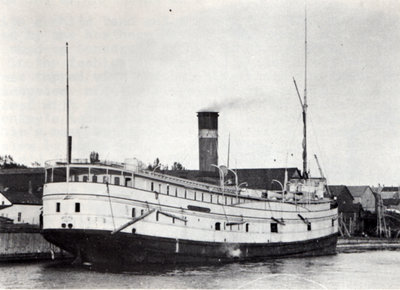
Very early but detailed stern view shows UNITED EMPIRE at Kincardine. Photo courtesy Ron Beaupre.
UNITED EMPIRE was a most impressive and handsome ship and certainly was the most advanced vessel of her type on the lakes and would be so until the big steel-hulled steamers became commonplace. Her hull had a beautiful sheer and was fitted with heavy fender strakes to prevent rubbing damage to the planking. Because of the length of the ship, strengthening of the wooden hull was required, and this was provided by arch trusses on each side, these braces being quite inconspicuous and rising only to just below the deckhead on the promenade deck. The steamer had a straight stem (it actually curved back a bit above the main deck) and a full and rather heavy counter stern. Three large cargo ports were provided on each side, as well as two smaller gangways farther aft. The cabin around the main deck area was closed in completely, even around the fantail, as was the custom in ships of this type.
On the promenade (or upper) deck above were located all of the passenger facilities. The deck was surrounded by a closed wooden rail all around; soon the rail was partially opened beneath the arches, however, to admit light behind the braces. The passenger staterooms were located in the promenade deck cabin and were very luxurious for the day. Each of the first class staterooms featured a large double bed, and many of these rooms could be made to communicate so as to accommodate large families or groups travelling together. Large curved-top windows let light into the rooms. Washing facilities were provided in each stateroom but, of course, the lavatories were "down the hall". Meals were served in the open lounge area between the rows of staterooms, this area being lighted by means of chandeliers and a high clerestory which ran almost the full length of the cabin. There was a smoking room for the gentlemen, and a comfortable lounge for the ladies. The ship could normally accommodate some 150 passengers in first and second class.
First class passengers, it should be noted, had their berths and. meals included in the price of their passage ticket. Second class passengers were provided with free berthing space but were required to provide their own bedding and to purchase their meals (in 1891 the cost of such meals was an extravagant 30 cents each!), but they were permitted to eat in the main cabin along with the first class. In the early years, UNITED EMPIRE and her fleetmates also carried a good number of immigrants who bought deck passage only and were required to shift for themselves on the freight deck. Needless to say, they did not enjoy the comfort of taking their meals in the cabin, and no doubt even had to provide their own food.
Far forward on the hurricane or boat deck was located UNITED EMPIRE's large and beautiful pilothouse, which probably was the ship's most impressive feature. It was tall and spacious, and sported four large, sectioned windows across its front, with three more windows and a door in each side. The woodwork of the pilothouse was most beautiful and fancy, and particularly the intricate, exterior angle-supports for the roof. The monkey's island was flat and originally was surrounded only by a low open rail, for no navigation was done from up there, and only a decorative finial graced the area. Within a short period of time, however, the monkey's island was converted into an open navigation bridge and was fitted with a high open rail, on which a canvas dodger frequently was hung, together with poles to support an awning for protection from the summer sun. Accommodation for the master was located in a small cabin set immediately abaft the pilothouse, all the other officers and crew being housed below.
The ship carried six lifeboats, three astride the clerestory on either side of the hurricane deck; two of the boats were set ahead of the stack, and one behind it. Rising up out of the master's cabin behind the pilothouse was the very tall and heavily raked, fidded mast, which was equipped with a prominent gaff and auxiliary sail. There were numerous sidepoles and a tall flagstaff aft. The very tall and heavy funnel was raked in proportion to the mast and boasted a fancy double cowl at its top. To protect against fire, the boiler uptakes came up through the cabin in a wide cellar which protruded well above the level of the boat deck clerestory. An apron topped the collar, and the stack rose out of it. A tall smoke pipe, which vented the galley stoves, sprouted out of the boat deck on the port side abreast the master's cabin. UNITED EMPIRE was painted in what by then had become the usual Beatty Line colours. Her hull was black up to the main deck, and the entire superstructure was painted white. The big mast was a buff colour, and the stack was red with a white band and a black top. (The Beatty stack colours were later adopted by the Northern Navigation Company and by that route eventually came to be used by Canada Steamship Lines, on whose vessels they remain to this day.) In the fashion of the era, almost every vertical projection aboard the ship was topped with a decorative acorn for luck; these appeared on the mast, the sidepoles, and the flagstaff aft, as well as other places, undoubtedly in gold leaf with the cap painted red. Fancy nameboards appeared on each side of the monkey's island, and also on the promenade deck rail aft of the arches. The ship's name appeared in large, fancy, shaded letters on the rail forward and below it appeared the company's "logo", which featured the legend "N.W. T. Co. Lim'd." and later included "G.T.R.R. for the Grand Trunk Railroad.
A fancy striped awning was often spread over the foredeck to afford shade to the passengers there, although passengers also frequented the boat deck and even the pilothouse roof, as photos of the day will show. The decorative effect of the ship's design was topped off by the lengthy spear pole which was hinged atop the stempost and raised or lowered to suit by a line which ran up and over a pulley near the top of the lofty mast. The spear pole had at its outer end several decorations, being a large ball, an even larger diamond, a smaller ball, and finally a battle axe at the tip.
UNITED EMPIRE entered service for the Northwest Transportation Company in the spring of 1883, running with MANITOBA, QUEBEC and ONTARIO. Their normal route took them from Sarnia to Goderich, Kincardine, Sault Ste. Marie, Port Arthur and Duluth, carrying many passengers and almost every type of general cargo that can be imagined.(It must be remembered that the steamboats and the railroads were then the only means of transporting goods to developing areas and the steamers were the lifeblood of many of the communities located on the lakes.) The Beatty boats often stopped at Southampton as well on upbound trips, although such a stop was not normally scheduled. Downbound, the ships usually ran straight through from the Soo to Sarnia, with passengers for the east shore of Lake Huron being railed from Sarnia on the Grand Trunk.
As the years passed, UNITED EMPIRE established a faithful following amongst the travelling public, and she seldom ran without a substantial load of passengers. She served without major accident and her followers often referred to her affectionately as "Old Betsy". We have no idea of the derivation of this nickname, as it seems to have had no relation to the steamer's actual name, but undoubtedly it simply was intended to reflect the ship's reputation for reliable and comfortable service, and the fondness with which she was regarded by all who knew her.
As time passed, more deck space was opened up for the passengers. An open rail was affixed along the sides of the boat deck clerestory from the pilothouse back to the funnel, and seats were placed there. A large framework was raised above this area and awnings were usually spread on it to provide protection from the hot sun. At about the same time, a short, thin pipe "mainmast" was stepped forward of the stack, its only apparent purpose being to carry the aft running light that the law then required.
One by one, UNITED EMPIRE's older running mates dropped by the wayside. MANITOBA left the route after her famous stranding behind Chantry Island at Southampton on November 14, 1883, and QUEBEC was sold after her sinking in the St. Mary's River in July of 1885. With business still very brisk, the Beatty Line required another vessel and so in 1889 it contracted with John Dyble to build at Sarnia a ship very similar to UNITED EMPIRE. The Beattys were rather traditional in their approach to shipbuilding and they would not order a steel-hulled ship such as those which were proving so successful in the C.P.R. fleet. Instead, the new ship was built of white oak, like her older sister.
The new steamer, which was stern-launched on June 27, 1890, was christened MONARCH, her name fitting in well with that of UNITED EMPIRE and giving an indication of the strongly patriotic views of the Beatty family, as well as reflecting the position which she would occupy on her route. MONARCH, which cost almost $200,000 to build, was slightly shorter than UNITED EMPIRE, although her Gross Tonnage was a bit greater and she was a little more powerful than her earlier "sister". The two were very much alike in appearance, but MONARCH could always be distinguished from UNITED EMPIRE in that she had a larger officers' cabin abaft the pilothouse, and her arches were lower, barely reaching above the promenade deck rail. As well, MONARCH did not have nearly as much decorative work built into her, and her pilothouse, although of similar size and shape, was downright plain in comparison with that of UNITED EMPIRE.
The two vessels fitted in well together and continued as running mates for more than fifteen years. The round trip from Sarnia to the Lakehead would take each steamer ten days, with departures from Sarnia normally on Tuesdays and Fridays. As an example, the 1891 schedule called for MONARCH to make the first upbound sailing of the season on May 5, with the vessels alternating trips (and together making either five or six sailings each month) until UNITED EMPIRE closed out the year by making her final arrival back at Sarnia on November 12. There may well have been more freight-only trips even later in the season.
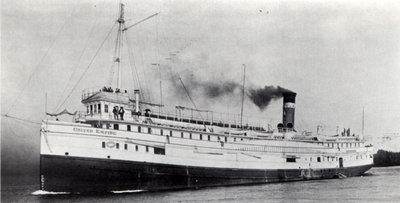
UNITED EMPIRE, in Beatty colours, is upbound in the St. Mary's River.
An upbound steamer would leave Sarnia at 10:00 p.m., and on Day Two of the trip she would sail from Goderich at 8:00 a.m. and from Kincardine at 1:30 p.m. She would depart the Soo at noon on Day Three, sail from Port Arthur at an unspecified time in the afternoon of Day Four, and arrive at Duluth early in the morning of the Fifth Day. She would sail from Duluth again at 7:30 p.m. on Day Six, leave Port Arthur at 1:00 p.m. on Day Seven, and clear the Soo sometime in the afternoon of Day Eight. Arrival back at Sarnia was in the early morning hours of Day Ten.
Connections were made at Sarnia with the Grand Trunk Railway, which operated through train services from many points in Canada and the U.S.A., and also with the Star Cole Line steamers which ferried passengers up from Detroit and points south. At the Soo, connections could be made with the Great Northern Transit Company's steamers for the Bay Ports, with the Delta Transportation Company boats for DeTour and Mackinac, and with the boats of the Lake Superior Transit Company and the Lake Michigan & Lake Superior Transportation Company for points along the south shore of Lake Superior. At the Soo, rail connections were available with the Duluth, South Shore & Atlantic Railway, and the Minneapolis, St. Paul & Sault Ste. Marie Railway.
At Port Arthur, of course, passengers could easily transfer to and from the Canadian Pacific Railway. At Duluth, connections were made with the south shore steamers again and also with a plethora of railroads, including the Northern Pacific, the Great Northern, the St. Paul & Duluth, the Duluth & Iron Range, and the Chicago, St. Paul, Minneapolis & Omaha Railway, all of these permitting passengers to continue their passage westward if so desired, and even right through to points on the west coast.
The company promoted itself as a tourist route, and the N.W.T.Co. advertised numerous tours all over North America, each of them incorporating a trip on UNITED EMPIRE or MONARCH as part of the journey. For example, a round trip from Sarnia to San Francisco, via various railways and steamer lines, cost $121.00 in 1891. Regular first class fares from Sarnia, Goderich or Kincardine to the Soo and return were $12.00, to Port Arthur and return cost $26.00, while a round trip to Duluth was $28.00 in the high season (June 1 through October 31). Fares undoubtedly were lower in the early and late portions of the season when there was little tourist travel.
The smaller ONTARIO of 1875 was still on the route during these years, but her passenger accommodations were far less comfortable than those on UNITED EMPIRE and MONARCH, and she spent much of her time hauling freight, particularly local supplies. (She had carried large quantities of supplies for use by the crews building the Canadian Pacific Railway during the 1880s.) ONTARIO was finally sold out of the Northwest Transportation Company in 1898, leaving UNITED EMPIRE and MONARCH to carry on alone.
One of the promotional statements made by the N.W.T.Co. through the years was that its vessels were staunch and strong, and that the company had never lost the life of a passenger through accident. Very few fleets could make such a statement in those days of wooden ships which frequently were burned or wrecked, but it was quite true in respect of the Beatty Line. No passenger was lost in any of the bumps or scrapes that all of the steamers sustained from time to time, nor were any lost when MANITOBA and QUEBEC suffered major accidents that took them out of the fleet. It is true that ASIA was owned by the Beattys when she foundered with considerable loss of life out on Georgian Bay in September of 1882, but at the time of the accident she was operating under charter to the Great Northern Transit Company and her day-to-day service was not under any control of the N.W.T.Co. The Beatty family had also owned the ill-fated steamer WAUBUNO at one time, but she was sold out of their fleet long before her tragic loss in 1879.
In the early years of the new century (after she had left Beatty control, as we shall see later), UNITED EMPIRE received an honour that few ships ever achieve, and that is to appear on a government note. For a number of years, the Dominion of Canada circulated four dollar notes, which first appeared in 1882 and continued in use until the more useful five dollar note was introduced about 1912. The first four dollar note featured a portrait of the Marquis of Lome, but in 1900 there appeared a new note which bore on its face a view of one of the C.P.R. ALBERTA-class steamers leaving a lock at the Soo. This was a rather pretty note, but it was not long before someone noticed that the lock from which the steamer was emerging was actually the Poe Lock of the American canal! This, of course, caused considerable consternation, for the pictures on Dominion government notes were supposed to illustrate typical Canadian scenes.
As a result, the four dollar note was reissued on January 2, 1902, this time bearing a handsome view of UNITED EMPIRE emerging downbound from the Canadian Soo Lock and, despite the date of issue of the note, the photo used was an older one which showed the steamer still wearing the N.W.T.Co. insignia on her bows. The ship appeared in the centre of the note's face, with portraits of the Earl and Countess of Minto appearing on the right and left sides, respectively. There were two separate issues of this note, with slightly different designations of denomination, but today both are extremely rare and valuable, and are much sought by marine historians as well as by collectors of banknotes.
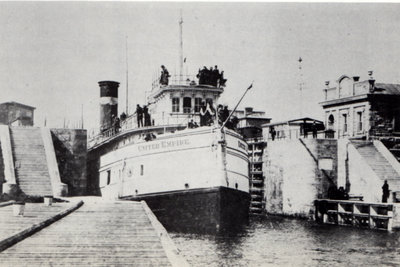
This view of UNITED EMPIRE leaving the Canadian Soo Lock appeared on the dominion four dollar noe of 1902.
Meanwhile, in 1899, there occurred a merger of two Georgian Bay steamboat lines that eventually would impact on UNITED EMPIRE. The North Shore Navigation Company Ltd. of Collingwood was formed about 1890 and was commonly known as the "Black Line" due to the colour of its ships' hulls. It competed directly with the Great Northern Transit Company, Collingwood, the "White Line", which traced its history back to 1875 when it was formed as the Georgian Bay Navigation Company. During the 1890s, there was fierce rivalry between the two lines as they vied for the passenger and freight business around Georgian Bay and into the North Channel of Lake Huron. Finally, early in 1899, North Shore Navigation bought out the Great Northern, and the two companies were merged under the banner of a new company, which was incorporated as the Northern Navigation Company of Ontario Ltd., Collingwood. The new firm began to send some of its steamers (particularly CITY OF COLLINGWOOD and MAJESTIC, which probably were the best of its ships) into Lake Superior, and as such began to compete with the Beatty Line boats.
The N.N.Co. and the Beattys may well have reached an agreement to co-operate for the duration of the 1899 season, but be this as it may, it was early in 1900 that John J. Long and Thomas Long of Collingwood, who were major shareholders of North Shore Navigation and then of Northern Navigation of Ontario, managed to acquire a controlling interest in the Northwest Transportation Company Ltd., although it would appear that the latter firm continued to exist as a separate operating entity for a few years.
The new company retained the Beatty Line stack colours, making them their own in the process, but it would seem that it was at this time that UNITED EMPIRE and MONARCH were given the white hull colour which had been taken from the old Great Northern fleet, and they lost the N.W.T.Co. logo from their bows. The white hull certainly did not become a vessel of UNITED EMPIRE's rather generous proportions, and it is fortunate indeed that she did not retain it for long. It was probably about this same time that the steamer was given a new and much shorter pole foremast. It was no longer necessary for steamers to carry auxiliary sail and thus there was no reason to retain the huge fidded foremast with which she had been built.
During 1902, the capital stock of Northern Navigation Company of Ontario was increased from $560,000 to $840,000 to purchase the minority stockholdings in Northwest Transportation ($147,000) and to complete payment for the new steel steamer HURONIC, which was commissioned in 1902 but which actually had been ordered from Collingwood by the N.W.T.Co. By means of this transaction, Northern Navigation came to own the entirety ($300,000) of the Northwest Transportation Company stock.
Also during 1902, John J. Long, formerly vice-president of Northern Navigation, became president of the company, succeeding the late James Scott. Long was also president of Northwest Transportation, and in 1902 acted as general manager of both firms. W. D. Matthews succeeded Scott as a director, while A. B. Pratt was assistant manager of N.N.Co., at Collingwood and William Askin, long an agent for the N.W.T.Co., was assistant manager of that company at Sarnia. But by 1904, Long had become embroiled in certain difficulties concerning some of his stockholdings, and H. C. Hammond had acquired control of Northern Navigation Company of Ontario Ltd., and thus also of the Northwest Transportation Company Ltd. It would seem likely that it was at this time that the two firms were merged into a company which was incorporated as the Northern Navigation Company Ltd., Sarnia, and which took over the operation of both divisions.
Over the winter of 1904-05, UNITED EMPIRE was rebuilt at Collingwood, and on April 12, 1905, she was renamed (b) SARONIC to bring her into line with ( the 'IC' name suffix style which had been adopted by the new firm, such names having originated in the Great Northern fleet many years previously. She was named for the City of Sarnia, with the additional 'O' added for ease of pronunciation. The ship was rebuilt with a raised forecastle enclosing the forward portion of the promenade deck, and with the rail closed in below the arches. An observation room with large windows was built atop the boat deck clerestory, and the forward lifeboat on each side was relocated aft of the rest of the boats. A new and fairly substantial pole mainmast was stepped well aft of the stack, and the galley stovepipe was moved over to the starboard side of the pilothouse. The hull became black up over the promenade deck rail, while the forecastle and the forward rail (now level with the boat deck) were white. The stack colours remained the same, although for several years the white band was narrowed somewhat.
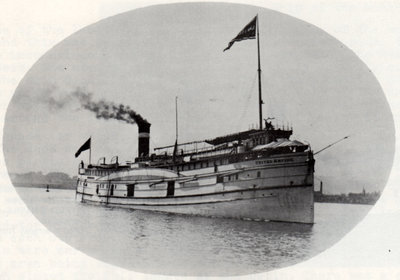
"Old Betsy", with her white hull, is seen at Sarnia shortly after the turn of the century.
UNITED EMPIRE, being of canal size, and because the upper lakes run could be handled by MONARCH and the new HURONIC, was diverted to run on the St. Lawrence River in 1905 after her rebuilding, but she returned to the upper lakes in 1906. The stability of the route was to be severely shaken, however, on the evening of December 6, 1906, when MONARCH, downbound from Port Arthur to Sarnia with a load of bagged flour, ran square into the high rock wall of Blake Point on the northeastern side of Isle Royale, and broke to pieces with the loss of one life. All the rest of the crew were able to scramble to safety ashore. (See Ship of the Month No. 60, November 1976 issue.) MONARCH's replacement in the N.N.Co. fleet was the big steel HAMONIC, arguably the most handsome passenger vessel ever to operate on the Great Lakes, which was launched at Collingwood on November 26, 1908, and which entered service in the spring of 1909. In the meantime, SARONIC remained on her Sarnia - Duluth run, and continued there for several further seasons.
On January 31, 1911, an offer to purchase the N.N.Co. for $1,250,000 was advanced by James Playfair and associates and the offer was rejected by the shareholders, but at the annual general meeting on March 25. 1911. Playfair succeeded in having himself elected president of the company. Then, with the support of G. A. Barnard of Montreal, Edmund Bristol of Toronto, and J. R. Binning of Furness, Withy & Company, Playfair began to negotiate for the consolidation of Northern Navigation with his Inland Lines Ltd. and the huge Richelieu and Ontario Navigation Company Ltd., Montreal. These efforts finally met with success in February of 1913. and the merger was instrumental in setting the stage for the supermerger that, in June of 1913, resulted in the formation of Canada Steamship Lines Ltd., Montreal.
Thus did SARONIC become a member of the C.S.L. fleet, but it meant no change of livery for her, for the Northern Navigation boats carried their own colours through the merger, and in the early 1920s the entire C.S.L. fleet adopted those colours. The Northern Navigation Company Ltd. had ceased to exist, but the Northern Navigation Division was to be a part of C.S.L. until its last ship, HURONIC, was retired at the close of the 1949 season. In 1913, SARONIC was transferred to the package freight service between Montreal and the Lakehead, and in 1914, with the big NORONIC in service on the upper lakes, SARONIC was moved over to the route from Quebec City to the various ports of the north shore of the Gulf of St. Lawrence. She was back on the lakes in 1915 and, on December 15 of that season, whilst laid up at Point Edward, she was badly damaged by fire. The blaze began aboard the steamer MAJESTIC which was moored nearby, and the flames spread to SARONIC. Fortunately, SARONIC was spared from destruction by the valiant efforts of the local fire brigade, although damage was estimated at $15,000.00, but MAJESTIC was not so lucky and was totally destroyed in the conflagration.
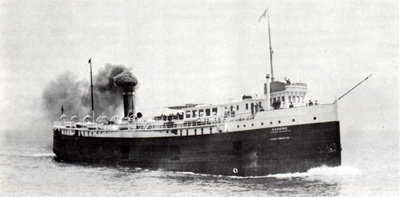
Spirited view of SARONIC was taken by J. Boyd, probably about 1910 on Lake Huron.
SARONIC was taken in hand by the Reid Wrecking Company, Sarnia, which reconstructed her as a steam barge for C.S.L. We know of no photo of her during this very brief stage of her career, but it is to be assumed that she simply was a cut-down version of her earlier self, with her passenger cabins cut away. She was back in service in the spring of 1916 and, on May 12, bound light from Cleveland to Fort William, she was damaged in a gale whilst eight miles off Copper Harbor, Michigan. Then, on Sunday, August 20, 1916, downbound from Fort William to Port McNicoll with a cargo of wheat, and under the command of Capt. J. W. Wintguay, she sprang a leak and was deliberately put ashore on Cockburn Island in Lake Huron in an effort to save her. Unfortunately, in the grounding, her galley stove was upset, and SARONIC was so damaged in the resulting fire that C.S.L. abandoned her to the underwriters. The loss was $135,000 to the ship and $30,000 to her cargo.
The hull was later salvaged and was sold to Winand Schlosser of Milwaukee, who had her rebuilt by the Milwaukee Dry Dock Company as a tow barge, 251.5 x 36.0 x 14.5, 1014 Gross and Net. Cut down to the old main deck, she had a raised forecastle, two heavy masts with booms that carried sail, a small after cabin, and a high pilothouse near the fantail. Renamed (c) W.L. KENNEDY in honour of Warner Lambert Kennedy, Schlosser's partner in the enterprise, she was enrolled in 1917 as U.S. 215206, registered at Marquette, Michigan, and she was operated in the pulpwood trade.
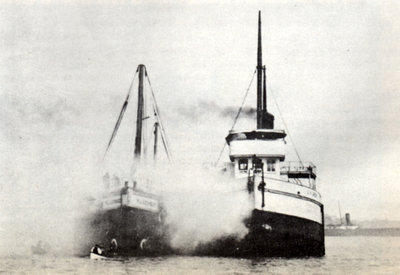
Unusual photo of W. L. KENNEDY and C.H. GREEN appears to have been taken on the St. Clair River. We know nothing of the circumstances.
The KENNEDY was sold in 1918 to the James R. Andrews Transportation Company of Escanaba, Michigan, which hauled pulp for the Detroit Sulphite Company, and the Lake Carriers Association reported that Detroit Sulphite actually purchased the big barge during 1919. She latterly carried Escanaba painted on her stern as home port, but we have been unable to find evidence that she was ever officially registered there.
Regardless of her actual ownership or registry, W. L. KENNEDY remained active as a tow barge until 1924, when she was abandoned in the Detroit River near Amherstburg. It has been suggested that the hull was intentionally set afire to reduce the upperworks (as often was the custom in those days), and the bones probably still lie in the mud of the river bottom.
Probably to no vessel more than the famous UNITED EMPIRE do the following words, adapted from C.H.J. Snider's "Schooner Days", apply more aptly. "Is it better with you, you brave, bluff-bosomed beauties long since burned or wrecked or rotted or scrapped, when your names are mentioned, and someone says 'Ah, yes, I remember...?'
"We like to think that it is; that the comfort of kindly recollection is a balm to the bruises you got in your few or many years of endurance of owners' urgency for dividends and the hammerings captains gave you, and the manhandling of greenhorn crews, and the ceaseless naggling of the winds and the waves and the docks and the beaches.
"It is pleasant to imagine that, when someone speaks of such and such a vessel, there is a little throb of happiness somewhere along the sands or the boulders or the boneyards, where the stout ships of yesteryear lie buried."
The faithful "Old Betsy" deserves nothing less...
Ed. Note: If the information presented herein concerning the formation of the Northern Navigation Company seems at variance with details published earlier in these pages, it is because we are constantly discovering new material regarding this transition. If any of our members have additional information, we would be pleased to hear from them.
Previous Next
Return to Home Port or Toronto Marine Historical Society's Scanner
Reproduced for the Web with the permission of the Toronto Marine Historical Society.